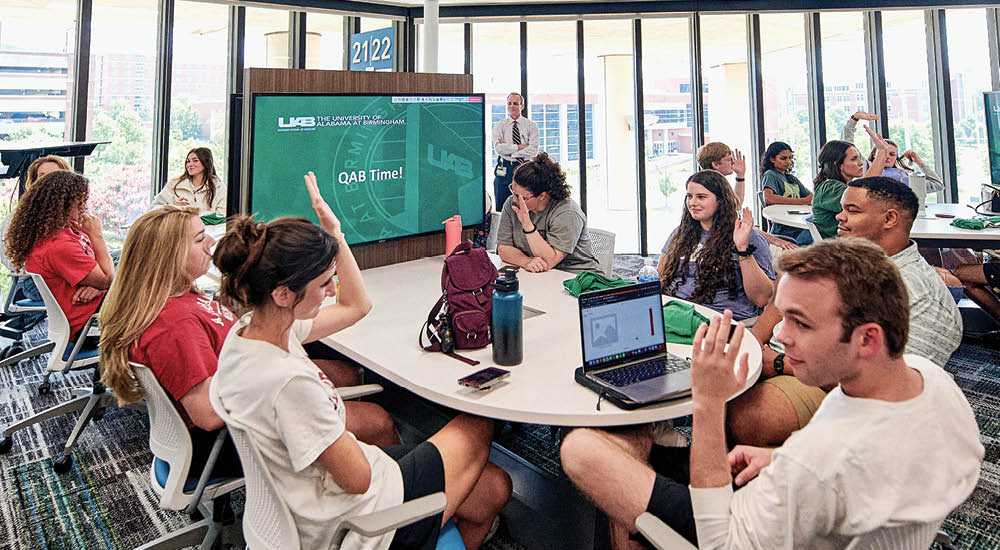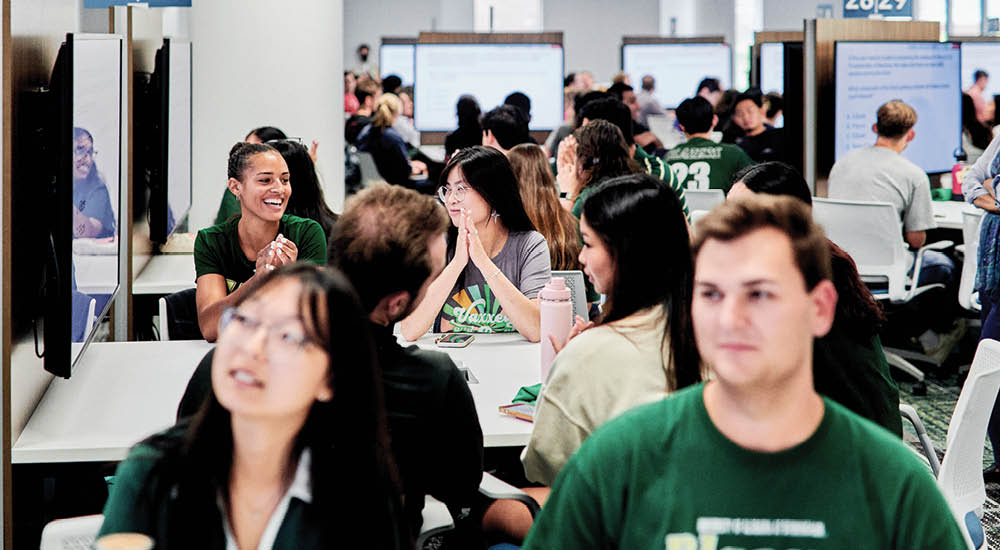This fall, the Heersink Family Active Learning Center officially launched in the Heersink School of Medicine’s medical education hub, Volker Hall’s Education Tower. Made possible by a philanthropic gift from the Heersink Family Foundation, the Active Learning Center features a “flipped classroom,” where students collaborate in small groups while using screens and digital teaching tools, with the instructor moving between them.
According to Will Brooks, Ph.D., assistant dean for Preclinical Education, active learning is “any instructional method that actively engages the learner in the learning process. It’s contrasted with passive learning, which is more of the lecture style of learning.”

The effectiveness of active learning is backed by research. “Cognitive psychologists and educational theorists have conducted research over the last couple of decades to better understand how people learn efficiently,” says Brooks. “What’s come out of this research is that people across the board learn better when actively engaged in the process and when challenged in some way. Again, contrast that with passive reception—we know that when you sit through a lecture, you retain a very small fragment of that information. When you engage in an active learning session, the retention is much higher.”
The Active Learning Center features 35 tables, each seating six students. Each table has a TV monitor and a microphone. “Instructors can mirror content to all TVs across the room from the lectern computer or their own device, like a phone or tablet,” Brooks says. “Students can also mirror content from their devices to their table’s TV. Microphones allow students who are speaking to the class at large to be heard by the entire room without having topass a microphone around.
 Brooks offers two examples of learning activities medical students will experience in the Active Learning Center. “One that we’ve been using for several years is team-based learning, or TBL, which falls under the flipped classroom umbrella,” Brooks explains. He says flipped classroom methods are ones where the delivery of content is moved out of the classroom for asynchronous, independent student learning—through watching videos or reading a textbook or journal article. Then the classroom is where instructors actively engage students in that material.
Brooks offers two examples of learning activities medical students will experience in the Active Learning Center. “One that we’ve been using for several years is team-based learning, or TBL, which falls under the flipped classroom umbrella,” Brooks explains. He says flipped classroom methods are ones where the delivery of content is moved out of the classroom for asynchronous, independent student learning—through watching videos or reading a textbook or journal article. Then the classroom is where instructors actively engage students in that material.
“In this example, students are given a series of short videos to watch, then when they come into the classroom, TBL has a series of steps,” Brooks says. “The first step is to complete a 10-question readiness assessment individually to self-assess their learning. Then students take the same assessment a second time as a team, working together to answer those same questions and engaging in peer teaching.
“Once those assessments are completed, students spend the rest of the class period working through applications of the information. In the medical school context, they work through a series of clinical cases, working in teams to answer questions and think through the process collaboratively.”
Brooks describes another active learning modality— a form of peer instruction—that will be used starting this year called QAB, which stands for “Questions @UAB.” “Students are again given materials to assimilate on their own, then when they come into the classroom, they work through a series of challenging questions like they might see on their board exams. The questions are multiple-choice, and the students use a polling system to click in what they think is the correct answer. The instructor gets immediate feedback on how much of the class got it right and how many got it wrong.
“If 80 percent or more of the class gets it correct, that’s considered good content mastery and the instructor can move on to the next question. But if less than 80 percent of the class gets it right, the teacher will put the same question up again. This time the students can work together to answer the question and re-poll their responses. Generally, you’ll see an increase in the number of correct responses, verifying the learning process.”
Brooks says these types of active learning methods are not only particularly appropriate for medical education but also a better fit for the current generation of students. “We need our physicians to be able to communicate with each other, with their patients, and with other health care providers, so we want students to develop the communication skills that are a core element of being a physician.
“In addition, today’s learners are all digital natives—they’ve grown up with YouTube and Instagram. They want to have options in how they assimilate information, and they want to do it in their own time. They also have shorter attention spans, that’s just the reality, so we want to take that into account and break up the content into smaller, more digestible chunks.”
A ribbon-cutting ceremony celebrating the launch of the Active Learning Center will take place November 15. Marnix Heersink, M.D., whose $95 million naming gift named the Heersink School of Medicine in 2021, is scheduled to attend, along with Senior Vice President for Medicine and Dean Anupam Agarwal, M.D., medical students, and the school’s medical education leaders, including Brooks.
-By Jane Longshore